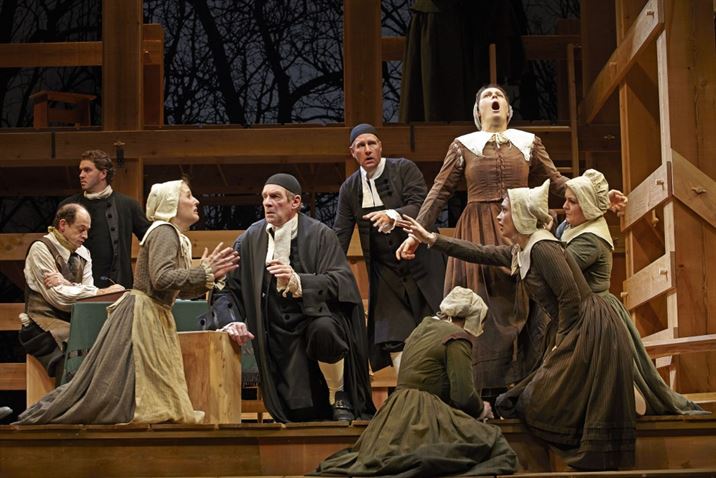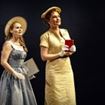 The cast of The Crucible, photo by Trudie Lee.
The cast of The Crucible, photo by Trudie Lee.
Playwright Arthur Miller wrote The Crucible in 1953. This was a time when rising fear during the Cold War allowed politicians to go on a crusade of inquisitions to find influential Americans with suspected ties to communism. Miller himself was a person of interest in the investigations conducted by the House Un-American Activities Committee (HUAC) and was required to attend a hearing when denied his American passport. In disclosing his political activities, Miller refused to name anyone else and was found guilty of contempt of Congress. This play is based on the Salem witch trials that took place in the Province of Massachusetts Bay in 1962. The situation that Miller was experiencing and the witch hunt in Salem are eerily similar.
Theatre Calgary’s The Crucible tells the story of John Proctor (Karl Sine) whose wife Elizabeth Proctor (Vanessa Sabourin) has been accused of witchcraft. Elizabeth however, is not the only one. Rebecca Nurse (Valerie Planche) has also been accused of dealing with the Devil by Ann Putnam (Karen Johnson-Diamond) and Thomas Putnam (Graham Percy), as they had seven still borns delivered by Rebecca. The girls of the village, led by Abigail Williams (Claire Armstrong), claim they have seen these women trafficking with spirits. Abigail wants to take Elizabeth’s place as John’s wife. Reverend John Hale (Graham Mothersill), a witch expert from another town, has come to help with the witch trials. These trials are led by Deputy-Governor Danforth (Stephen Hair) with assistance from Judge Hathorne (Brian Jensen). The play deals in justice, fear and power. It shows the terrible road we can go down when anyone can accuse another of witchcraft with faulty ‘evidence’ that can bring about their death. It tells the story of a church with power wanting to control people with fear.
Theatre Calgary’s production of The Crucible, directed by R.H Thomson is a slow burn of tension. The play is very well written and Miller’s words do not seem foreign for any of the cast. Sine’s performance as John Proctor is outstanding. His experience with Shakespearean language has him performing the denser speeches with ease. He was emotive and steady. Sabourin pairs well with Sine to show Elizabeth’s reserved nature and her ‘coldness.’ No one on stage builds as much hate within the audience as Claire Armstrong’s Abigail. Armstong manages to wield the character without going over the top. Also of note is Graham Mothersill’s Reverend John Hale. With the most character growth to go through, Mothersill is strong within his character arch and shows his ability to realistically portray Hale’s change of heart.
There is much risk of going over the top and Theatre Calgary’s production manages to keep from crossing the line. When Abigail is pretending to see Mary Warren’s spirit, the play threatens to go into hysteria and lose its audience. Instead, Thomson ensures that the narrative is steady throughout.
The only aspect that is slightly disappointing about this production is Cameron Porteous’ set design. A simple backdrop of trees is the set throughout the play and a wooden structure is built on stage (you can hear the cast building it during intermission), to backdrop the court scenes. It is simple, and fits within the constraints of the play, but there could have been more to it.
Miller’s message is clear and resonates in Thomson’s hands. We cannot be driven by fear, as it leads to hysteria, resulting in every human being turning on their neighbours. It’s a message that resonates today within our own politics, in our own country. We are always pushed to fear the ‘other’ in our society. We need to just look at the past to see what we need to do in the present. Miller experienced it in his time, and the question is, what will you do when the hysteria of fear comes for you?
Theatre Calgary’s The Crucible runs until November 8th. More information is available online.
Related Posts
| Tweet |
|






